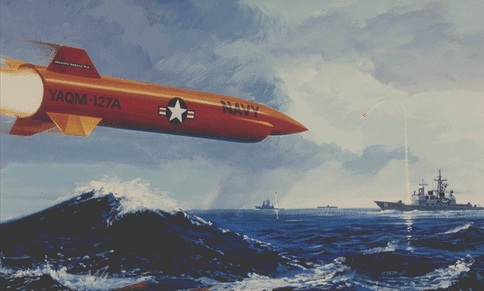Martin Marietta AQM-127 SLAT
Following the cancellation of the BQM-111 program, the U.S. Navy in late 1983 issued a new requirement for a low-level, high-speed aerial target to simulate anti-ship missile threats. The new program was called YAQM-127A SLAT (Supersonic Low-Altitude Target). The SLAT requirement called for a parachute-recoverable and reusable target, which could be launched from DC-130, QF-4, A-6, F/A-18 and P-3 aircraft.
After a competition with LTV (who bid an ALVRJ derivative) and Teledyne Ryan (who bid a new design), Martin Marietta was awarded a contract to develop the AQM-127 in September 1984, with a cost estimate which was even less that of the internal Navy estimate. Initial Operational Capability was planned for 1991, with operations planned eventually for the AFWTF (Atlantic Fleet Weapons Test Facility), WSMR (White Sands Missile Range) and the PMR (Pacific Missile Range). A primary role was that of testing the capabilities of DDG-51 Aegis class ships.
Martin Marietta's YAQM-127A design was derived from the ASALM (Advanced Strategic Air-Launched Missile) vehicles, which were flight-tested in the 1978/80 time frame. Like ASALM, it used a hybrid rocket/ramjet propulsion system to propel the missile to a speed of Mach 2.5 at very low altitudes of 9 m (30 ft) above the sea surface. In the hybrid propulsion system, the rocket booster becomes an intergral part of the ramjet engine once its solid propellant is all burnt. The YAQM-127A was to fly a pre-programmed course (cross-checked against range instrumentation) with optional manual override. Main equipment were to be multi-band radar augmentors, a radar seeker emulator, and scoring equipment.
 |
| Image: Martin Marietta |
| YAQM-127A |
15 YAQM-127A test vehicles were built with the first flight occurring on 20 November 1987. Six launches were conducted from November 1987 to January 1989; only one was considered to be successful. A stand down lasting 22 months was then imposed by the Navy in order to restructure the program and correct technical deficiencies. A second flight test effort was then attempted with launches in November 1990 and May 1991; both flights were unsuccessful. In the midst of efforts to restructure the program once again, Congressional action in mid-1991 terminated the program. Test failures, schedule slippage and massive program cost growth were major factors in the cancellation.
After the cancellation of the earlier BQM-90 and BQM-111 Firebrand programs, this was the Navy's third consecutive failure to develop a dedicated high-speed anti-ship missile threat simulator. Following the limited use of the Russian MA-31 missile (the actual threat system the AQM-127 was to emulate), the current effort in this area is the GQM-163 SSST (Supersonic Sea-Skimming Target) program.
Specifications
Note: Data given by several sources show slight variations. Figures given below may therefore be inaccurate!
Data for YAQM-127A:
| Length | 5.47 m (17 ft 11.5 in) |
| Diameter | 54.0 cm (21.25 in) |
| Weight | 1090 kg (2400 lb) |
| Speed | Mach 2.5 |
| Range | 100 km (55 nm) |
| Propulsion | Marquardt ramjet sustainer with integrated Morton Thiokol solid-rocket booster |
Main Sources
[1] Kenneth Munson: "World Unmanned Aircraft", Jane's, 1988
Back to Current Designations Of U.S. Unmanned Military Aerospace Vehicles
Back to
Directory of U.S. Military Rockets and Missiles
Last Updated: 18 October 2006